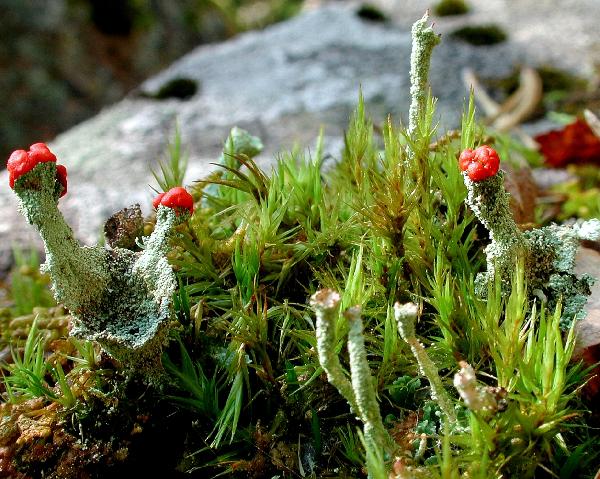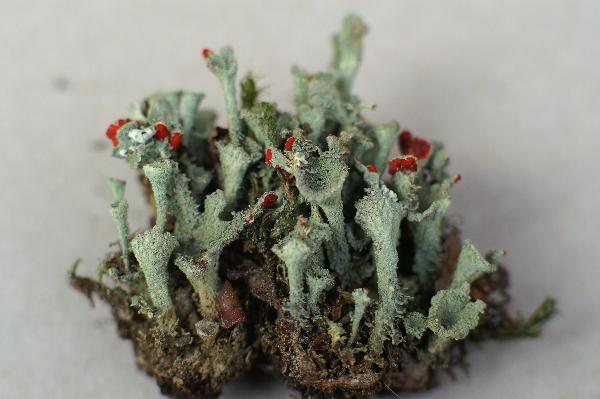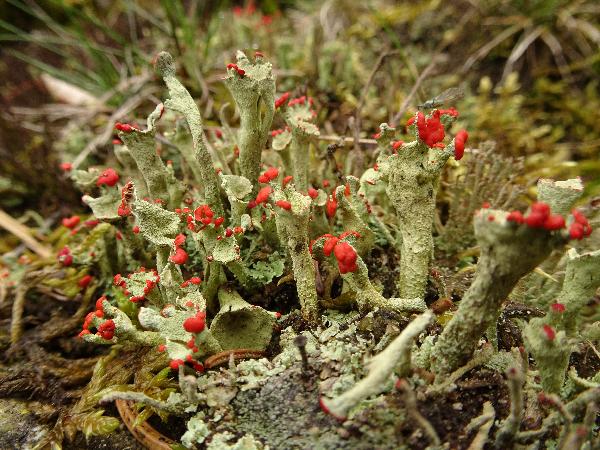Cladonia pleurota (Flörke) Schaer.
Enum. Crit. Lich. Eur.: 186, 1850. Basionym: Capitularia pleurota Flörke - Ges. naturf. Fr. Berlin Mag., 2: 217, 1808.
Synonyms: Cladonia coccifera var. pleurota (Flörke) Schaer.
Description: Primary thallus squamulose, persistent, the squamules variable, rounded to sparsely indented, 1-6 mm long, up to 4 mm broad, irregularly crenate, yellowish green to olivaceous green above, white beneath (sometimes yellowish near the attachment point). Podetia goblet-shaped, hollow inside, yellowish green, 0.5-2(-3) cm tall, with 0.5-1.5 cm broad, regular cups soon flaring into short, 0.5-1.5 mm thick stalks, the margins of cups sometimes dentate or proliferating, esquamulose or sometimes sparsely squamulose at base, corticate only at base (more corticate in fertile specimens), granulose- or almost farinose-sorediate, the soredia 60-100 μm in diam., present also inside and on margins of cups. Apothecia rather rare, scarlet red, often compound and shortly stipitate. Asci 8-spored, clavate, thickened at apex, with a K/I+ blue tholus and a K/I+ strongly blue outer gelatinous sheath, Cladonia-type. Ascospores 1-celled, hyaline, ellipsoid. Pycnidia scarlet red to black, stipitate or semi-immersed along the margin of cups (rarely on the primary squamules), with a red jelly. Conidia hyaline, curved. Photobiont chlorococcoid. Spot tests: K-, C-, KC+ yellow, P-, UV-. Chemistry: usnic, isousnic, porphyrilic acids, and zeorin (seen as crystals on the thallus surface in herbarium specimens); rhodocladonic acid in apothecia and pycnidia.
Growth form: Fruticose
Substrata: soil, terricolous mosses, and plant debris
Photobiont: green algae other than Trentepohlia
Reproductive strategy: mainly asexual, by soredia, or soredia-like structures (e.g. blastidia)
Commonnes-rarity: (info)
Alpine belt: rather rare
Subalpine belt: very common
Montane belt: very rare
Dry submediterranean belt: absent
Humid submediterranean belt: absent
Padanian area: absent
pH of the substrata:
1 2 3 4 5
Solar irradiation:
1 2 3 4 5
Aridity:
1 2 3 4 5
Eutrophication:
1 2 3 4 5
Poleotolerance:
0 1 2 3
Altitudinal distribution:
1 2 3 4 5 6
Rarity
absent
extremely rare
very rare
rare
rather rare
rather common
common
very common
extremely common
Loading data...
Occurrence data
Predictive map
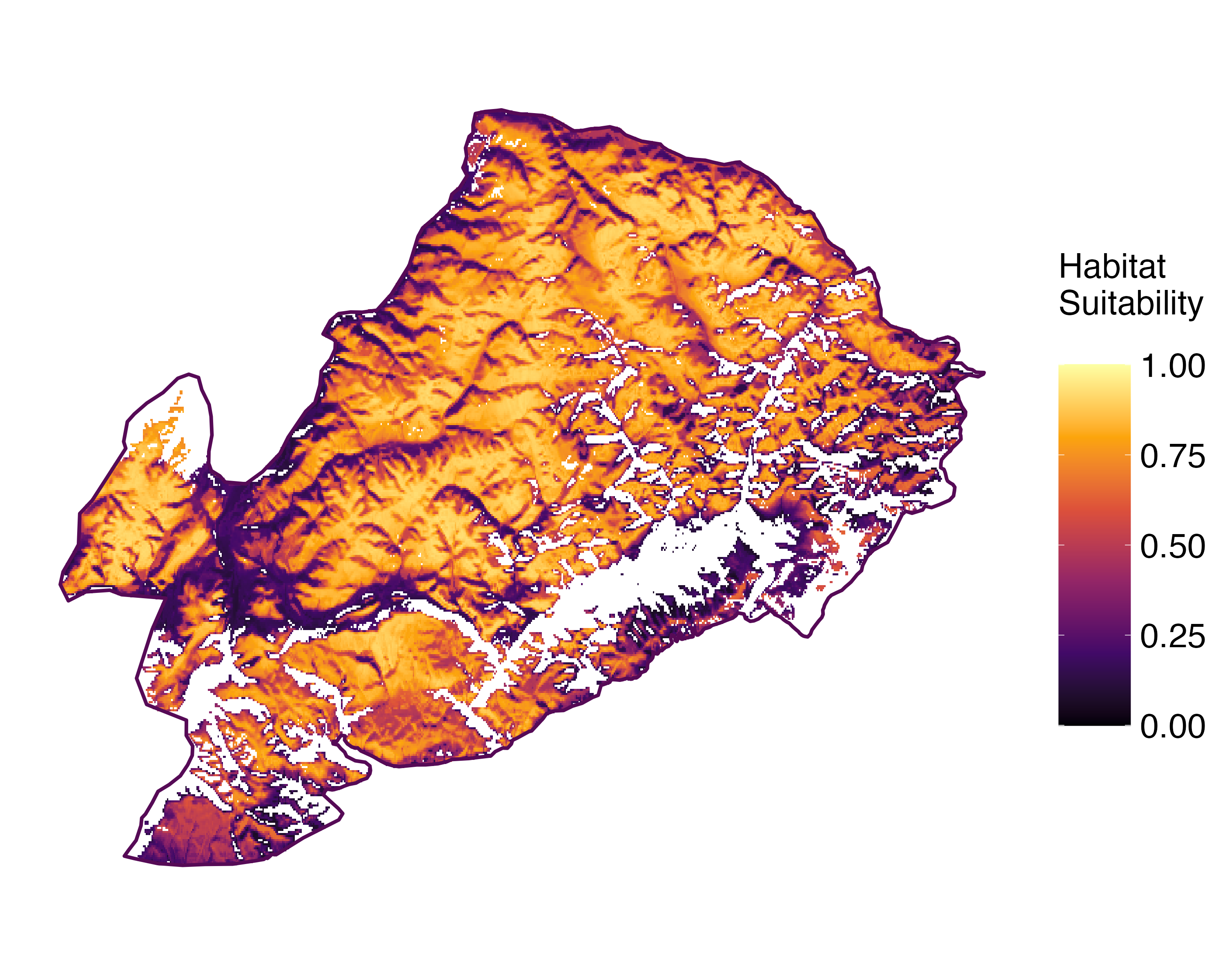 Current prediction (1981-2010)
Current prediction (1981-2010) Future prediction (2071-2100) SSP 1-2.6
Future prediction (2071-2100) SSP 1-2.6 Future prediction (2071-2100) SSP 5-8.5Predictive maps according to Francesconi et al. 2025
Future prediction (2071-2100) SSP 5-8.5Predictive maps according to Francesconi et al. 2025
P.L. Nimis; Owner: Department of Life Sciences, University of Trieste
Herbarium: TSB (21155)
2003/02/15
detail of pycnidia at the margin of cups

P.L. Nimis; Owner: Department of Life Sciences, University of Trieste
Herbarium: TSB (21155)
2003/02/15

Gabriele Gheza - https://lichenidilombardia.home.blog
Italy, Lombardia, Brescia, Ponte di Legno, 1750 m
08/2020

Arnaud Delhoume - Source: http://www.lichensmaritimes.org/index.php?task=fiche&lichen=1178&lang=en
France, Nièvre

Arnaud Delhoume - Source: http://www.lichensmaritimes.org/index.php?task=fiche&lichen=1178&lang=en
France, Nièvre

Arnaud Delhoume - Source: http://www.lichensmaritimes.org/index.php?task=fiche&lichen=1178&lang=en
France, Nièvre

Arnaud Delhoume - Source: http://www.lichensmaritimes.org/index.php?task=fiche&lichen=1178&lang=en
France, Nièvre

Arnaud Delhoume - Source: http://www.lichensmaritimes.org/index.php?task=fiche&lichen=1178&lang=en
France, Nièvre
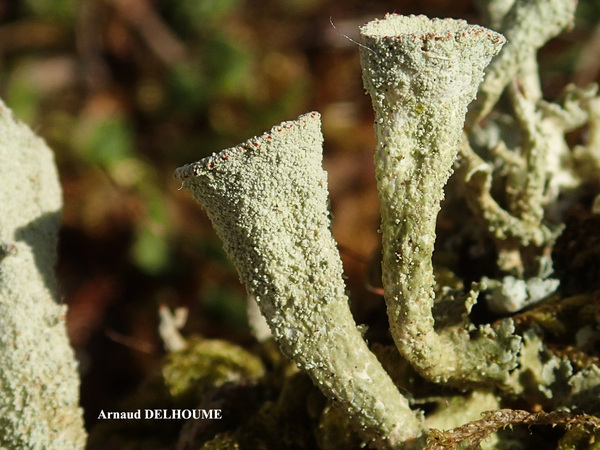
Arnaud Delhoume - Source: http://www.lichensmaritimes.org/index.php?task=fiche&lichen=1178&lang=en
France, Nièvre

Arnaud Delhoume - Source: http://www.lichensmaritimes.org/index.php?task=fiche&lichen=1178&lang=en
France, Nièvre
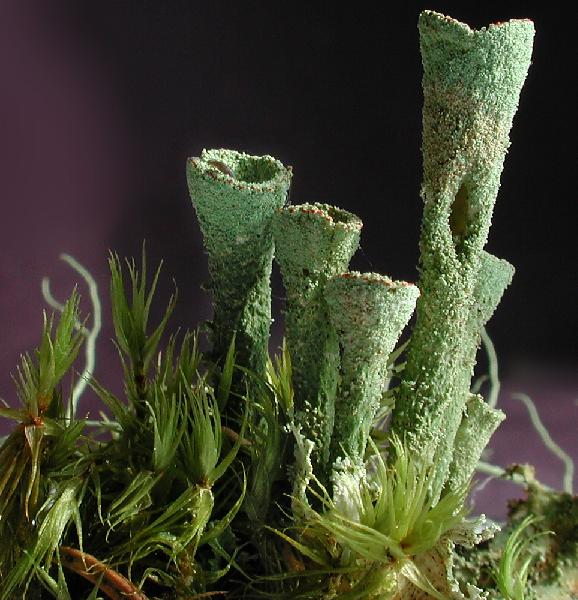
Ulrich Kirschbaum CC BY-SA 4.0 - Source: https://www.thm.de/lse/ulrich-kirschbaum/flechtenbilder
Sweden: Värmland.
Growth form: Fruticose
Substrata: soil, terricolous mosses, and plant debris
Photobiont: green algae other than Trentepohlia
Reproductive strategy: mainly asexual, by soredia, or soredia-like structures (e.g. blastidia)
Commonnes-rarity: (info)
Alpine belt: rather rare
Subalpine belt: very common
Montane belt: very rare
Dry submediterranean belt: absent
Humid submediterranean belt: absent
Padanian area: absent
pH of the substrata:
| 1 | 2 | 3 | 4 | 5 |
Solar irradiation:
| 1 | 2 | 3 | 4 | 5 |
Aridity:
| 1 | 2 | 3 | 4 | 5 |
Eutrophication:
| 1 | 2 | 3 | 4 | 5 |
Poleotolerance:
| 0 | 1 | 2 | 3 |
Altitudinal distribution:
| 1 | 2 | 3 | 4 | 5 | 6 |
Rarity
absent
extremely rare
very rare
rare
rather rare
rather common
common
very common
extremely common
Loading data...
Occurrence data
Predictive map
 Current prediction (1981-2010)
Current prediction (1981-2010) Future prediction (2071-2100) SSP 1-2.6
Future prediction (2071-2100) SSP 1-2.6 Future prediction (2071-2100) SSP 5-8.5
Future prediction (2071-2100) SSP 5-8.5Predictive maps according to Francesconi et al. 2025

P.L. Nimis; Owner: Department of Life Sciences, University of Trieste
Herbarium: TSB (21155)
2003/02/15
detail of pycnidia at the margin of cups

P.L. Nimis; Owner: Department of Life Sciences, University of Trieste
Herbarium: TSB (21155)
2003/02/15

Gabriele Gheza - https://lichenidilombardia.home.blog
Italy, Lombardia, Brescia, Ponte di Legno, 1750 m
08/2020

Arnaud Delhoume - Source: http://www.lichensmaritimes.org/index.php?task=fiche&lichen=1178&lang=en
France, Nièvre

Arnaud Delhoume - Source: http://www.lichensmaritimes.org/index.php?task=fiche&lichen=1178&lang=en
France, Nièvre

Arnaud Delhoume - Source: http://www.lichensmaritimes.org/index.php?task=fiche&lichen=1178&lang=en
France, Nièvre

Arnaud Delhoume - Source: http://www.lichensmaritimes.org/index.php?task=fiche&lichen=1178&lang=en
France, Nièvre

Arnaud Delhoume - Source: http://www.lichensmaritimes.org/index.php?task=fiche&lichen=1178&lang=en
France, Nièvre

Arnaud Delhoume - Source: http://www.lichensmaritimes.org/index.php?task=fiche&lichen=1178&lang=en
France, Nièvre

Arnaud Delhoume - Source: http://www.lichensmaritimes.org/index.php?task=fiche&lichen=1178&lang=en
France, Nièvre














